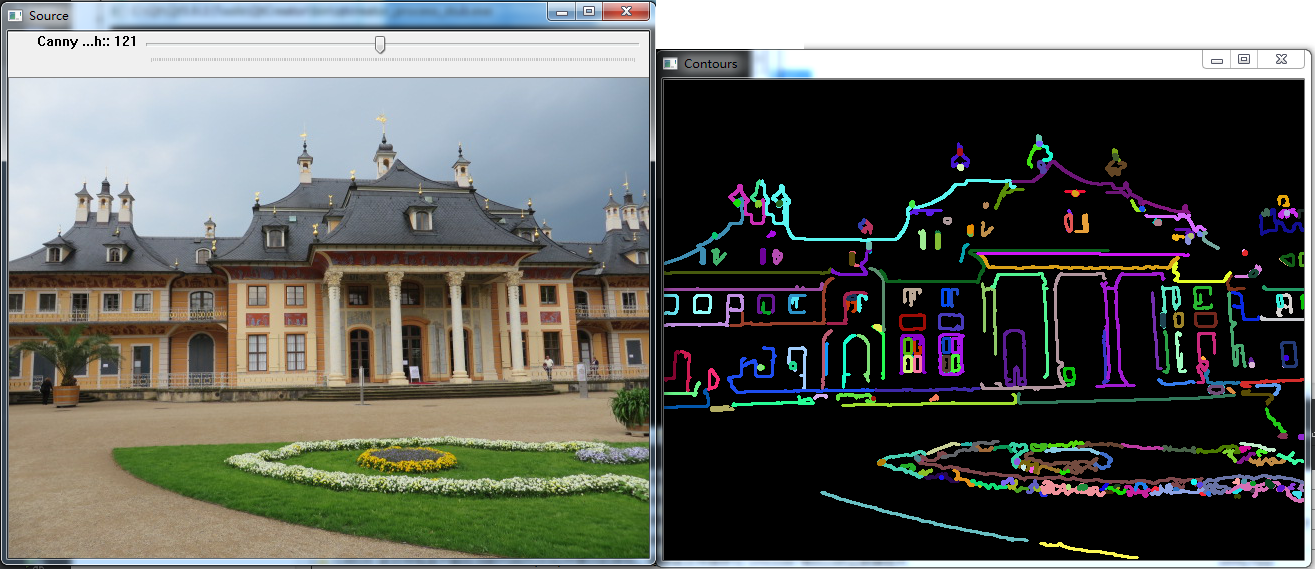OpenCV 之 圖像分割 (一)
1 基於閾值
1.1 基本原理
灰度閾值化,是最簡單也是速度最快的一種圖像分割方法,廣泛應用在硬件圖像處理領域 (例如,基於 FPGA 的實時圖像處理)。
假設輸入圖像為 f,輸出圖像為 g,則經過閾值化處理的公式如下:
$\quad g(i, j) = \begin{cases} 1 & \text{當 f(i, j) ≥ T 時} \\0 & \text{當 f(i, j) < T 時} \\ \end{cases} $
也即,遍歷圖像中的所有像素,當像素值 f (i, j) ≥ T 時,分割後的圖像元素 g (i, j) 是物體像素,否則為背景像素。
如果各個物體之間彼此不接觸,並且物體灰度和背景灰度之間差別比較明顯時,灰度閾值化便是非常合適的分割方法。
1.2 cv::threshold 函數
OpenCV 中的閾值化函數為 threshold,其使用如下所示:
double cv::threshold ( InputArray src, // 輸入圖像 (單通道,8位或32位浮點型) OutputArray dst, // 輸出圖像 (大小和類型,都同輸入) double thresh, // 閾值 double maxval, // 最大灰度值(使用 THRESH_BINARY 和 THRESH_BINARY_INV類型時)int type // 閾值化類型(THRESH_BINARY, THRESH_BINARY_INV; THRESH_TRUNC; THRESH_TOZERO, THRESH_TOZERO_INV) )
1) THRESH_BINARY
$\qquad dst(x, y) = \begin{cases} maxval & \text{if src(x, y) > thresh} \\0 & \text{otherwise} \\ \end{cases} $
2) THRESH_TRUNC
$\qquad dst(x, y) = \begin{cases} threshold & \text{if src(x, y) > thresh} \\src(x, y) & \text{otherwise} \\ \end{cases} $
3) THRESH_TOZERO
$\qquad dst(x, y) = \begin{cases} src(x, y) & \text{if src(x, y) > thresh} \\0 & \text{otherwise} \\ \end{cases} $
1.3 示例
下面是閾值化類型和閾值可選的代碼示例,摘自 OpenCV 例程,略作修改
#include "opencv2/imgproc.hpp" #include "opencv2/imgcodecs.hpp" #include "opencv2/highgui.hpp" using namespace cv; int threshold_value = 0; int threshold_type = 3; int const max_value = 255; int const max_type = 4; int const max_BINARY_value = 255; Mat src, src_gray, dst; const char* window_name = "Threshold Demo"; const char* trackbar_type = "Type: \n 0: Binary \n 1: Binary Inverted \n 2: Truncate \n 3: To Zero \n 4: To Zero Inverted"; const char* trackbar_value = "Value"; void Threshold_Demo(int, void*); int main( int, char** argv ) { // 讀圖 src = imread("Musikhaus.jpg",IMREAD_COLOR); if( src.empty() ) return -1; // 轉化為灰度圖 cvtColor( src, src_gray, COLOR_BGR2GRAY ); // 顯示窗口 namedWindow( window_name, WINDOW_AUTOSIZE ); // 滑動條 - 閾值化類型 createTrackbar( trackbar_type, window_name, &threshold_type,max_type,Threshold_Demo); // 滑動條 - 閾值 createTrackbar( trackbar_value,window_name, &threshold_value,max_value,Threshold_Demo); Threshold_Demo(0, 0); waitKey(0); } void Threshold_Demo(int, void*) { /* 0: Binary 1: Binary Inverted 2: Threshold Truncated 3: Threshold to Zero 4: Threshold to Zero Inverted */ threshold(src_gray, dst, threshold_value, max_BINARY_value, threshold_type); imshow(window_name, dst); }
2 基於邊緣
前一篇 <OpenCV 之 邊緣檢測> 中,介紹了三種常用的邊緣檢測算子: Sobel, Laplace 和 Canny 算子。
實際上,邊緣檢測的結果是一個個的點,並不能作為圖像分割的結果,必須采用進一步的處理,將邊緣點沿著圖像的邊界連接起來,形成邊緣鏈。
2.1 輪廓函數
OpenCV 中,可在圖像的邊緣檢測之後,依次使用 cv::findContours 和 cv::drawContours 函數,尋找到輪廓並將其畫出
void cv::findContours ( InputOutputArray image, // 源圖像 OutputArrayOfArrays contours, // 檢測到的輪廓 OutputArray hierarchy, // int mode, // 輪廓獲取模式 (RETR_EXTERNAL, RETR_LIST, RETR_CCOMP,RETR_TREE, RETR_FLOODFILL) int method, // 輪廓近似算法 (CHAIN_APPROX_NONE, CHAIN_APPROX_SIMPLE, CHAIN_APPROX_TC89_L1, CHAIN_APPROX_TC89_KCOS) Point offset = Point() // 輪廓偏移量 )
cv::drawContours 函數各參數如下:
void cv::drawContours ( InputOutputArray image, // 目標圖像 InputArrayOfArrays contours, // 所有的輸入輪廓 int contourIdx, // const Scalar & color, // 輪廓顏色 int thickness = 1, // 輪廓線厚度 int lineType = LINE_8, // InputArray hierarchy = noArray(), // int maxLevel = INT_MAX, // Point offset = Point() // )
2.2 例程
代碼摘自 OpenCV 例程,略有修改
#include "opencv2/imgcodecs.hpp" #include "opencv2/highgui.hpp" #include "opencv2/imgproc.hpp" using namespace cv; using namespace std; Mat src,src_gray; int thresh = 100; int max_thresh = 255; RNG rng(12345); void thresh_callback(int, void* ); int main( int, char** argv ) { // 讀圖 src = imread("Pillnitz.jpg", IMREAD_COLOR); if (src.empty()) return -1; // 轉化為灰度圖 cvtColor(src, src_gray, COLOR_BGR2GRAY ); blur(src_gray, src_gray, Size(3,3) ); // 顯示 namedWindow("Source", WINDOW_AUTOSIZE ); imshow( "Source", src ); // 滑動條 createTrackbar("Canny thresh:", "Source", &thresh, max_thresh, thresh_callback ); // 回調函數 thresh_callback( 0, 0 ); waitKey(0); } // 回調函數 void thresh_callback(int, void* ) { Mat canny_output; vector<vector<Point> > contours; vector<Vec4i> hierarchy; // canny 邊緣檢測 Canny(src_gray, canny_output, thresh, thresh*2, 3); // 尋找輪廓 findContours( canny_output, contours, hierarchy, RETR_TREE, CHAIN_APPROX_SIMPLE, Point(0, 0) ); Mat drawing = Mat::zeros( canny_output.size(), CV_8UC3); // 畫出輪廓 for( size_t i = 0; i< contours.size(); i++ ) { Scalar color = Scalar( rng.uniform(0, 255), rng.uniform(0,255), rng.uniform(0,255) ); drawContours( drawing, contours, (int)i, color, 2, 8, hierarchy, 0, Point() ); } namedWindow( "Contours", WINDOW_AUTOSIZE ); imshow( "Contours", drawing ); }
以 Dresden 的 Schloss Pillnitz 為源圖,輸出如下:

參考資料:
OpenCV Tutorials, imgproc module, Basic Thresholding Operations
OpenCV Tutorials, imgproc module, Finding contours in your image
<圖像處理、分析與機器視覺_第3版> 第 6 章
Topological structural analysis of digitized binary images by border following [J], Satoshi Suzuki, 1985
OpenCV 之 圖像分割 (一)
